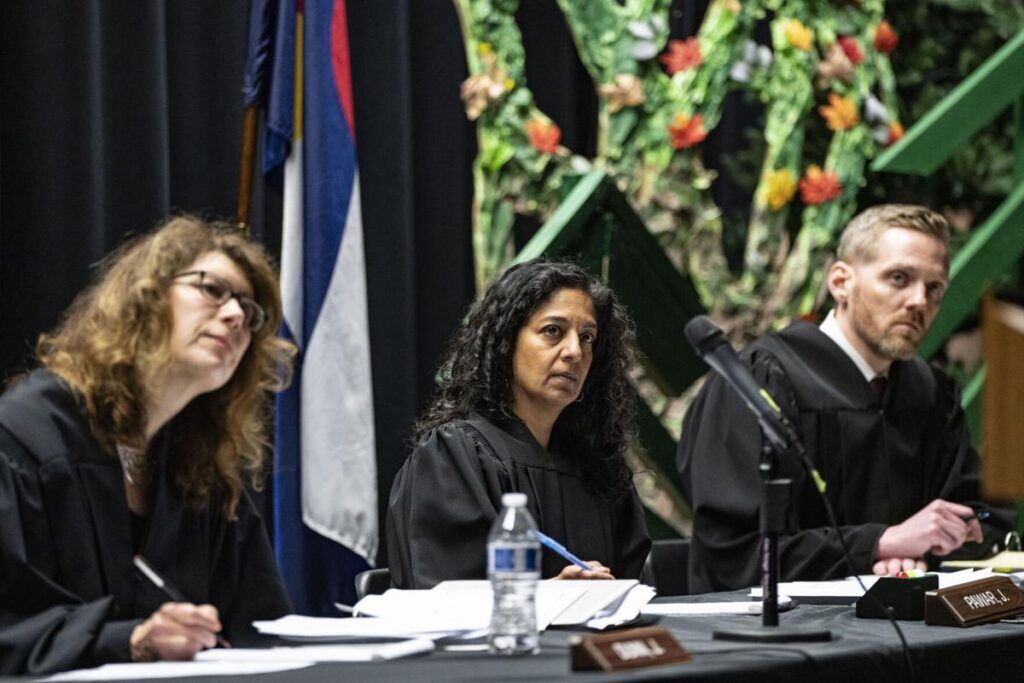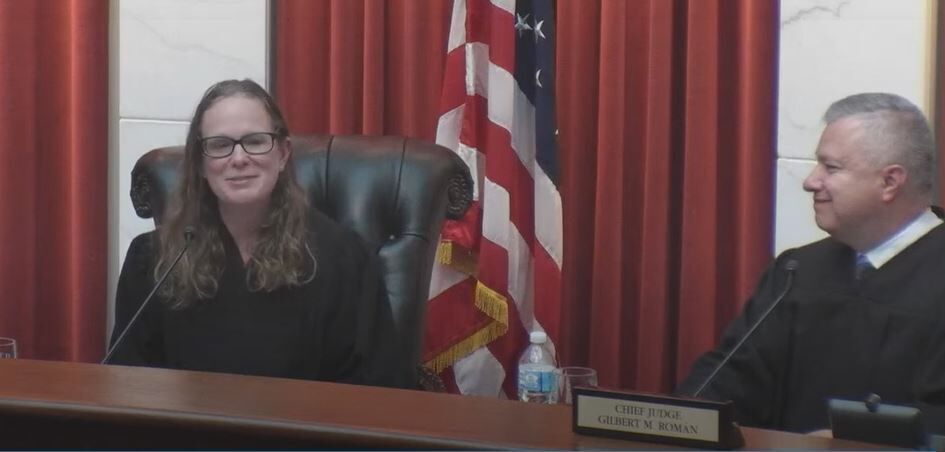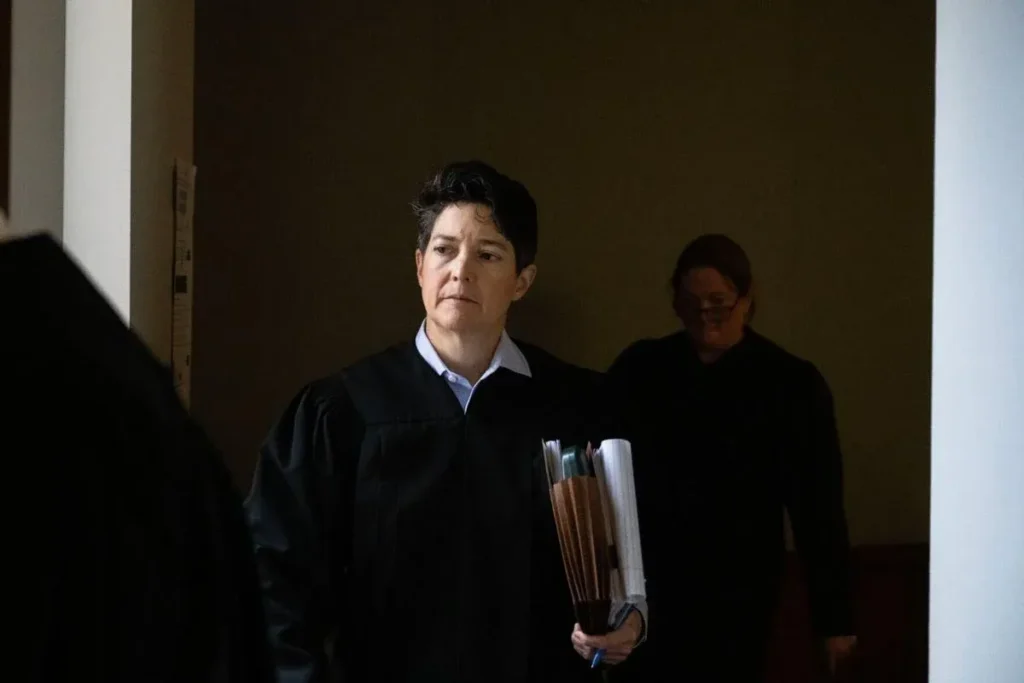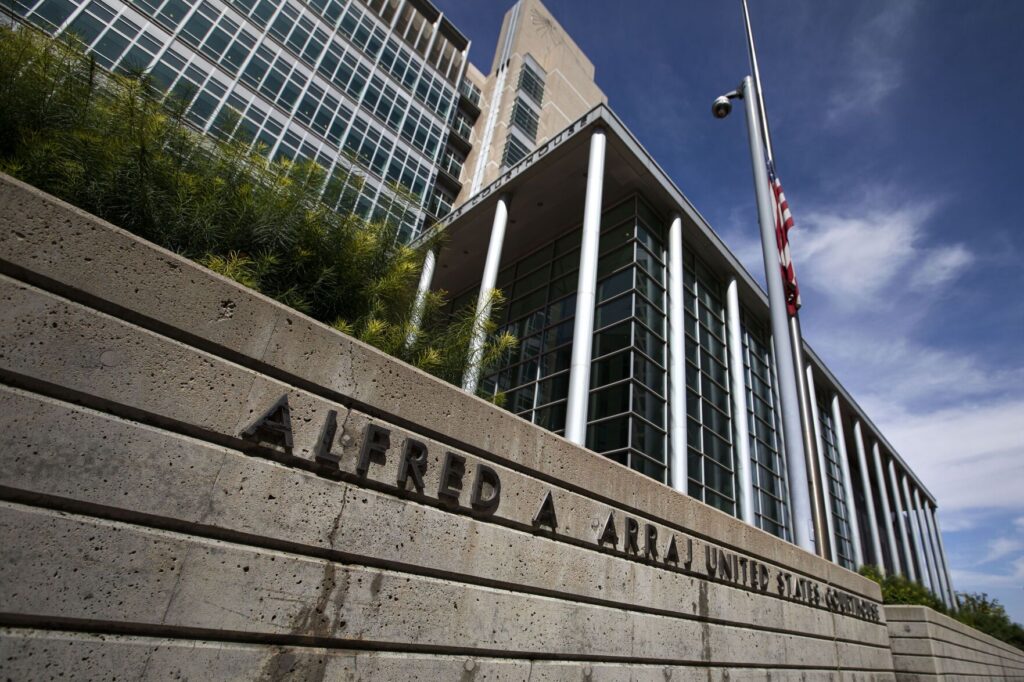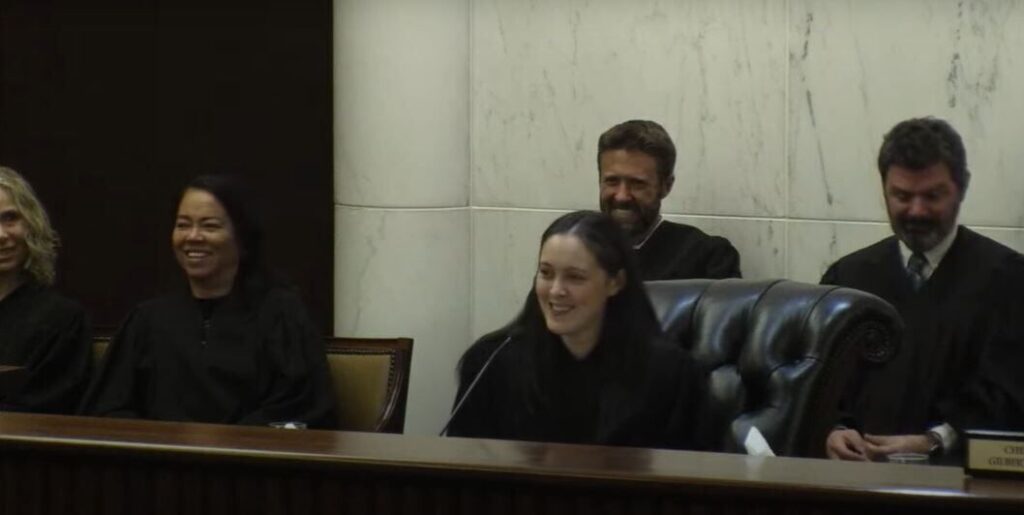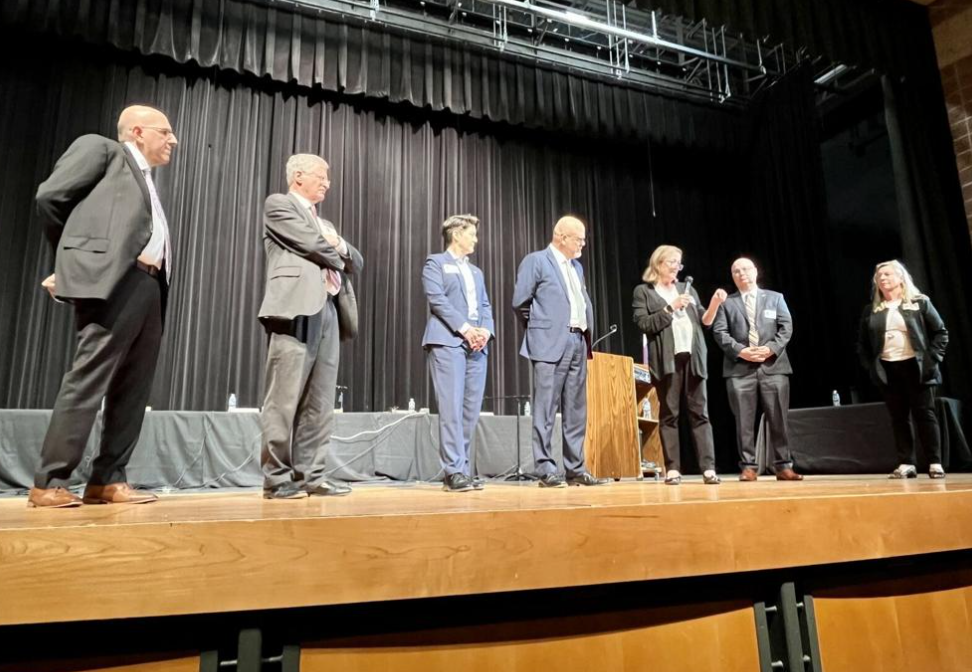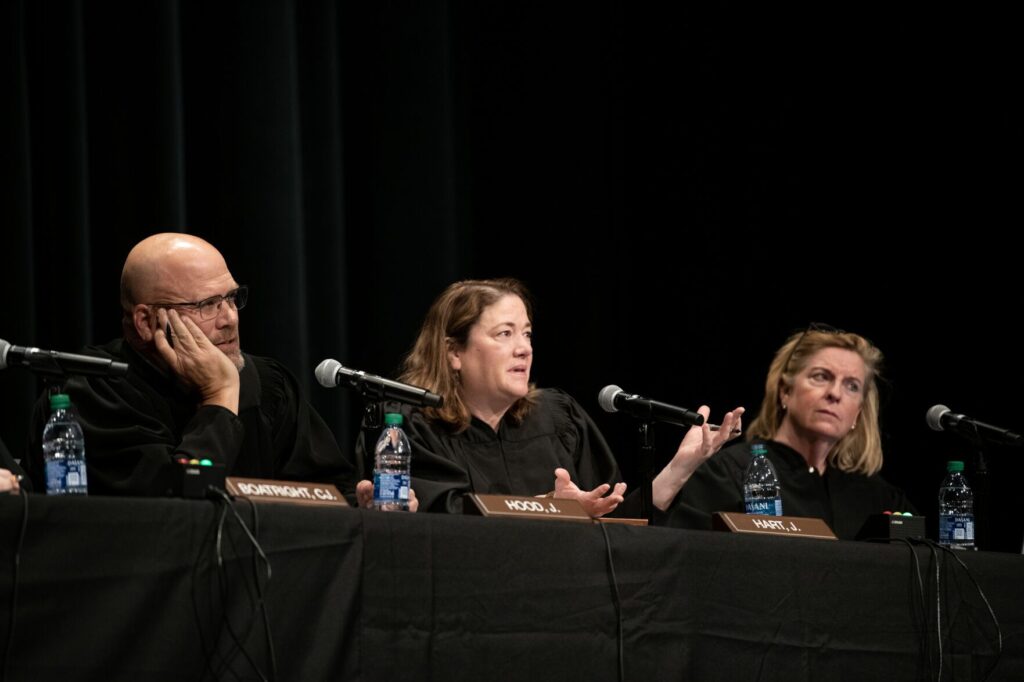State Supreme Court weighs immunity for dangerous sidewalks, a bullet hole experiment

Can a woman who badly injured herself on a Boulder sidewalk take the city to court for her fall? Was a police investigator’s novel experiment on the shapes of bullet holes, in fact, junk science?
The Colorado Supreme Court on Tuesday heard arguments for two cases in which the state’s second-highest court issued divided opinions on the complex issues of governmental immunity and expert witness testimony.
The arguments took place at Pomona High School in Arvada as part of the Judicial Department’s 35-year-old Courts in the Community initiative.
“Remember when you were little and got to go on field trips to the zoo or someplace cool? That’s how we feel,” Chief Justice Brian D. Boatright told the audience.
In the first case, Maphis v. Boulder, a sidewalk trip-and-fall presented a less-than-straightforward problem – one that could held determine whether cities across the state abandon their proactive sidewalk repair efforts for fear of being sued.
Joy Maphis tripped over an uneven sidewalk in the 1100 block of Pennsylvania Avenue in Boulder in April 2017. The impact caused a shattered right elbow and a broken left elbow, with additional damage to her lip. She underwent two surgeries to regain the range of motion in her arm.
A month before her trip, the city marked the sidewalk for repair. The cause of her fall was a 2.5-inch deviation between sidewalk slabs. By contrast, the city of Boulder’s sidewalk repair program deemed as a hazard any gap greater than three-quarters of one inch.
But in attempting to sue Boulder for her injuries, Maphis encountered a hurdle: the Colorado Governmental Immunity Act.
“The Governmental Immunity Act includes a counterintuitive notion that some risks are reasonable,” Luis Toro with the Boulder City Attorney’s Office said during Tuesday’s arguments.
Governmental immunity serves as a shield from civil lawsuits, on the theory that it would be disruptive to government operations and costly to taxpayers for public entities to fend off litigation. However, immunity does not apply in cases where sidewalks are known to be in a dangerous condition that creates “an unreasonable risk to the health and safety of the public.”
Despite the gap being three-times the size that Boulder considers a hazard, Toro did not concede that a 2.5-inch deviation was more dangerous than three-quarters of an inch. He indicated that trial lawyers go looking for cities like Boulder that have proactive repair programs because they can then show in court that a municipality knew about the risk to pedestrians. If the Supreme Court ruled for Maphis, he advised the justices in his brief, it may prompt cities to “end proactive repair programs” and put on a veil of ignorance to defend themselves against lawsuits.
Supporting him was the Colorado Municipal League, which represents 270 of the 272 municipalities in Colorado, as well as the Colorado Intergovernmental Risk Sharing Agency, an insurance pool for municipalities. In a brief filed with the Supreme Court, the organizations argued that sidewalk tripping hazards are so prevalent that cities should, in effect, receive blanket immunity.
“Irregularities in a sidewalk’s surface at joints between the concrete slabs are so common in municipalities throughout Colorado, pedestrians can and should anticipate these hazards and usually avoid them,” the organizations wrote. “Precisely because they are so common, the trip-and-fall risks associated with this kind of sidewalk condition cannot be considered ‘beyond reason’ as a matter of law within the meaning of the CGIA.”
Some members of the court balked at the notion that once a problem is widespread enough, it should excuse governments from liability.
“Does that not set up a situation where the more prevalent or risky or potentially dangerous situation that exists, the more likely it is that the city will be immune because there’s so many of them?” asked Justice Monica M. Márquez.
“The city knows it’s a hazard and they walk away. ‘Oh, we’ll get to it.’ But in the meantime someone comes along…and is severely injured. And you want us to hold, she doesn’t even get to court,” added Justice Carlos A. Samour, Jr.
In June 2020, a three-judge panel for the Court of Appeals found that Maphis had not established the sidewalk’s condition presented an unreasonable risk to the public and granted Boulder immunity. The majority of the panel called attention to testimony from Boulder’s principal transportation projects engineer, who admitted that budgetary constraints and contractor schedules affect the ability of the city to repair its sidewalks.
Judge David J. Richman dissented, believing a locality that has widespread problems with its infrastructure – and fails to alert pedestrians to the danger – deserves to be held liable.
“When a city knows of a dangerous condition but elects to defer repairs because it is not a priority, the city, not the citizen, should bear the risk,” he wrote. “The city may make an administrative decision not to fix a broken sidewalk; but when it declares the sidewalk a ‘hazard,’ and does nothing to fix it, it has created a dangerous condition and its failure to act is unreasonable.”
In response to student questions at the end of oral arguments, Toro said Boulder has no cones to denote hazardous sidewalk sections and no staff to grind down the deviations. Those are the responsibilities of contractors. He added that there are more than 4,000 locations in Boulder where sidewalk deviations exceeded three-quarters of one inch.
Randall Paulsen, the attorney for Maphis, disagreed that the city’s hands are tied.
“There’s about 100 different ways to do this,” he said. “You can take a can of spray paint. You can put a cone or a barricade in front of it. You can surround it with tape. You can put up a warning tape “The city goes, ‘We don’t do that. We don’t have the staff.’ The question is: why not?”
People v. Ornelas-Licano
The second case asked whether a police investigator with years of experience in ballistics and crime scene reconstruction should have been able to share his opinion as an expert about bullet hole shapes to a jury, based on an experiment he performed only once.
As police in Fort Collins prepared to arrest Jose Ornelas-Licano on a warrant, Ornelas-Licano, who was sitting in his pickup truck in a driveway, initially complied. Suddenly, he placed his hand against his head, told officers to “shoot me here” and began driving away.
Orenlas-Licano was holding his gun during the pursuit because, he later claimed, he was fearful that the officers were acting like “Rambo.” At one point, the gun went off, shooting a bullet through Ornelas-Licano’s windshield while an officer was in the vicinity. Orenlas subsequently crashed but ran away on foot and was eventually arrested.
Prosecutors claimed Ornelas-Licano was trying to shoot at the officer and charged him with attempted murder. Ornelas-Licano asserted that he was shifting gears on his truck’s manual transmission and the gun had accidentally discharged. A Larimer County jury found him guilty.
Ornelas-Licano appealed, arguing the trial court judge should not have allowed the jury to hear testimony from Daniel Gilliam. Throughout his career, Gilliam had worked with firearms for 36 years, was a SWAT member for six years and studied, as a sniper, bullet trajectories and impacts. For Ornelas-Licano’s trial, Gilliam conducted an experiment: He ordered two windshields that were the same type as in the pickup truck. He shot Ornelas-Licano’s gun first from a shoulder-height position and second from the level of the stick shift.
After studying each bullet shape, he concluded that the shape of the bullet hole from a shoulder-height discharge was the same as in Ornelas-Licano’s actual windshield – suggesting the gun was fired intentionally. He testified as an expert witness to the jury about his findings, a court designation that means he possessed knowledge an ordinary person did not.
James S. Hardy, representing Ornelas-Licano before the Supreme Court, disputed the notion that Gilliam’s onetime experiment designed specifically for trial indicated expertise. The trial court, he said, should have excluded the testimony as junk science, especially because the results could have been random.
“This is like I’m walking down the sidewalk in Boulder with a cup of coffee and I trip on a sidewalk that has a three-quarter-inch deviation and it spills into a Christmas tree pattern. Do I extrapolate that every time I spill my coffee it will be a Christmas tree?” Hardy said, referencing the Maphis case.
The Court of Appeals previously agreed with Ornelas-Licano, reversing his attempted murder conviction April 2020 by a 2-1 vote. Other than Gilliam’s experiment, “The record is devoid of any showing that the shape of a bullet hole in a windshield is demonstrative or indicative of the angle at which the bullet struck the glass,” wrote Judge Craig R. Welling for the majority.
The Colorado Attorney General’s Office appealed to the Supreme Court, arguing that Gilliam’s testimony was more than anecdotal, because it relied on his years of experience and observation around firearms.
“The expert in this case depended on the most basic and elemental scientific method. As we all know from school, you see something, you come up with a hypothesis and test it,” Senior Assistant Attorney General John T. Lee told the court.
“Should we be troubled at all by the apparent absence of scholarly work, peer-reviewed analysis of this methodology?” asked Justice William W. Hood III. “There is no subset of forensic science looking specifically at the kinds of holes bullets make traveling through glass.”
Other members of the court noted that expert witnesses have a lot of credibility with jurors, and police experts in particular. In this case, Hood added, the police expert was saying, “take my word for it. I’ve seen these holes before.”
Taking student questions after the oral arguments, Lee conceded that it would have been better had Gilliam repeated the test for reliability’s sake. When one student pointed out that saying two shapes are similar might not be scientifically precise, Hardy agreed.
“My position is no, it was not, especially when you do it just one time,” he explained. “If someone came into the courtroom and said the DNA was ‘similar enough’ to the defendant’s DNA, we would not accept that, right?”




